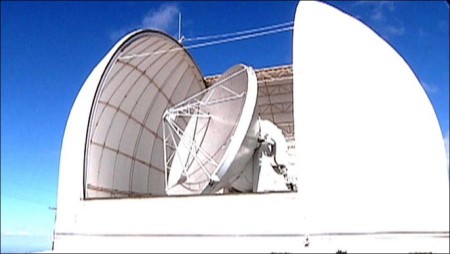The world’s biggest astronomy project provides a view of space unmatched by other observatories.
A powerful telescope affording a view of the universe unmatched by most ground-based observatories gazed onto distant galaxies for the first time Monday from deep in Chile’s Atacama desert.
The Atacama Large Millimeter/submillimeter Array, a joint project between Canada, Chile, the European Union, Japan, Taiwan and the United States, officially opened for astronomers after a decade of planning and construction.
The world’s biggest astronomy project, ALMA is described as the most powerful millimeter/submillimeter-wavelength telescope ever and the most complex ground-based observatory.
The first images arrived at the mega-site in northern Chile from 12 of the 66 radio telescopes.
“Today marks the recognition of the successful coalition of thousands of people from all over the world all working with the same goal: to build the world’s most advanced radio telescope to see into the universe’s coldest, darkest places, where galaxies and stars and perhaps the building blocks of life are created,” said ALMA director Thijs de Graauw.
ALMA differs from visible-light and infrared telescopes by using an array of linked antennas acting as a single giant telescope, and detects much longer wavelengths than those of visible light, rendering images unlike most others of the cosmos.
Although similar instruments are used in other locations, ALMA’s are 10 to 100 times more powerful than others currently in operation, said ALMA scientist Lars Nyman.
ALMA’s location also provides a unique advantage, because of the extreme aridity of the Atacama and its altitude of 5,000 meters (16,400 feet). It is in the same region as the European Extremely Large Telescope, due to begin operation in 2018.
The first images were of the Antennae Galaxies, a pair of colliding galaxies with dramatically distorted shapes some 70 million light years away in the Corvus constellation.
ALMA’s view “reveals something that cannot be seen in visible light: the clouds of dense cold gas from which new stars form,” according to ALMA. “This is the best submillimeter-wavelength image ever made of the Antennae Galaxies.”
Images like “will be vital in helping us understand how galaxy collisions can trigger the birth of new stars,” said ALMA.
Project scientist Richard Hills told AFP that the results were “better than expected.”
“They’re really beautifully clear, there’s nothing that messes up the data… it really shows us what is going on inside their galaxies we had been looking for,” the former Cambridge University scientist added.
“We’ve been waiting a very long time to get to the point where ALMA is really able to do science. Some people have been working on this project for more than 20 years. So, it has been a long road, but all the bits and pieces that we need to make this telescope work, now come together.”
One of the projects chosen for ALMA observations was that of David Wilner of the Harvard-Smithsonian Center for Astrophysics in Cambridge, Massachusetts.
“My team hunts for the building blocks of solar systems, and ALMA is uniquely equipped to spot them,” Wilner said.
His target is AU Microscopii, a star 33 light years away that is only one percent of the age of the sun.
“We will use ALMA to image the ‘birth ring’ of planetesimals that we believe orbits this young star,” he said. “We hope to discover clumps in these dusty asteroid belts, which can be the markers of unseen planets.”
Masami Ouchi of the University of Tokyo will use ALMA to observe Himiko, a very distant galaxy churning out at least 100 suns’ worth of stars every year and surrounded by a giant, bright nebula.
“Other telescopes cannot show us why Himiko is so bright and how it has developed such a huge, hot nebula when the ancient universe all around it is so calm and dark,” said Ouchi.
Views: 222



